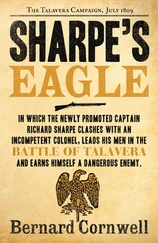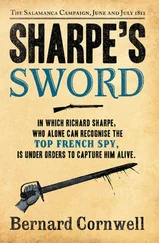SHARPE’S
REVENGE
Richard Sharpe and the Peace of 1814
BERNARD CORNWELL

This novel is a work of fiction. The incidents and some of the characters portrayed in it, while based on real historical events and figures, are the work of the author’s imagination.
Harper
An imprint of HarperCollins Publishers Ltd.
1 London Bridge Street
London SE1 9GF
www.harpercollins.co.uk
Previously published in paperback by HarperCollins in 1994
(reprinted four times)
and by Fontana in 1990 (reprinted four times)
First published in Great Britain by Collins 1989
Copyright © Rifleman Productions Ltd 1989
Bernard Cornwell asserts the moral right to be identified as the author of this work
A catalogue record for this book is available from the British Library
All rights reserved under International and Pan-American Copyright Conventions. By payment of the required fees, you have been granted the non-exclusive, non-transferable right to access and read the text of this ebook on-screen. No part of this text may be reproduced, transmitted, down-loaded, decompiled, reverse engineered, or stored in or introduced into any information storage and retrieval system, in any form or by any means, whether electronic or mechanical, now known or hereinafter invented, without the express written permission of HarperCollins ebooks
HarperCollins Publishers has made every reasonable effort to ensure that any picture content and written content in this ebook has been included or removed in accordance with the contractual and technological constraints in operation at the time of publication
Source ISBN: 9780007298532
Ebook Edition © JULY 2009 ISBN: 9780007338726
Version: 2017-04-26
For Whiskey
Table of Contents
Title Page SHARPE’S REVENGE Richard Sharpe and the Peace of 1814 BERNARD CORNWELL
Copyright Copyright This novel is a work of fiction. The incidents and some of the characters portrayed in it, while based on real historical events and figures, are the work of the author’s imagination. Harper An imprint of HarperCollins Publishers Ltd. 1 London Bridge Street London SE1 9GF www.harpercollins.co.uk Previously published in paperback by HarperCollins in 1994 (reprinted four times) and by Fontana in 1990 (reprinted four times) First published in Great Britain by Collins 1989 Copyright © Rifleman Productions Ltd 1989 Bernard Cornwell asserts the moral right to be identified as the author of this work A catalogue record for this book is available from the British Library All rights reserved under International and Pan-American Copyright Conventions. By payment of the required fees, you have been granted the non-exclusive, non-transferable right to access and read the text of this ebook on-screen. No part of this text may be reproduced, transmitted, down-loaded, decompiled, reverse engineered, or stored in or introduced into any information storage and retrieval system, in any form or by any means, whether electronic or mechanical, now known or hereinafter invented, without the express written permission of HarperCollins ebooks HarperCollins Publishers has made every reasonable effort to ensure that any picture content and written content in this ebook has been included or removed in accordance with the contractual and technological constraints in operation at the time of publication Source ISBN: 9780007298532 Ebook Edition © JULY 2009 ISBN: 9780007338726 Version: 2017-04-26
Dedication For Whiskey
Epigraph ‘The Richard Sharpe novels are notable for their wonderfully astringent view of history. Sharpe is a man first and a patriot second: he is as likely to pick a fight with one of his own side as charge blindly towards the enemy’ Sunday Telegraph
Map
Part One PART ONE
Prologue
Chapter One
Chapter Two
Chapter Three
Part Two
Chapter Four
Chapter Five
Chapter Six
Chapter Seven
Chapter Eight
Chapter Nine
Part Three
Chapter Ten
Chapter Eleven
Chapter Twelve
Part Four
Chapter Thirteen
Chapter Fourteen
Chapter Fifteen
Epilogue
Historical Note
Sharpe’s Story
Keep Reading
About the Author
The SHARPE Series (in chronological order)
The SHARPE Series (in order of publication)
Also by Bernard Cornwell
About the Publisher
‘The Richard Sharpe novels are notable for their wonderfully astringent view of history. Sharpe is a man first and a patriot second: he is as likely to pick a fight with one of his own side as charge blindly towards the enemy’
Sunday Telegraph

PART ONE

Major Richard Sharpe had made every preparation for his own death. His horse, Sycorax, and his fine French telescope would go to Captain William Frederickson, his weapons would become the property of Sergeant Patrick Harper, while everything else would belong to his wife Jane. Everything, that was, except for the uniform in which Sharpe always fought. That uniform consisted of knee-high riding boots, French cavalry overalls, and a faded green jacket of the 95th Rifles. Sharpe had asked to be buried in that uniform.
‘If you weren’t buried in those rags,’ Frederickson observed disdainfully, ‘they’d be burned anyway.’
It was true that the leather boots had been deeply scarred by knives, bayonets and sabres, and that the overalls were so patched with brown homespun that they looked more like a ploughman’s cast-off breeches than the plundered uniform of a Chasseur Colonel of Napoleon’s Imperial Guard, and that the green jacket was so faded and threadbare that even a moth could not have made a decent meal from it, but the clothes were still those in which Sharpe fought and were therefore dear to him. He might have looked like a scarecrow in the old uniform, but wearing it for battle was one of his obsessive superstitions, which was why, on a cold March morning in 1814, and despite being miles from any enemy soldier, Sharpe wore the old clothes.
‘You’ll have to take off the jacket,’ Frederickson, who understood Sharpe’s superstitious attachment to the uniform, warned his friend.
‘I know.’ There was no detail of this morning that Sharpe had not rehearsed again and again in his mind. What would happen this morning was called ‘grass before breakfast’. It sounded innocuous, but it could well mean death.
The two men stood on a low grassy bluff above a grey and sullen Atlantic. A long and heaving swell was running from the west to break against the rocks beneath. To the north of the bluff was the French port of St Jean de Luz that was crammed with merchant shipping and fishing boats, while in the harbour’s outer roads a small Royal Navy flotilla lay at anchor. The flotilla consisted of three sloops, two frigates, and a great chequer-sided battleship, the Vengeance .
It was a shivering dawn, yet spring was coming and with the spring would come a resurgence of battle. The Emperor Napoleon had refused the peace terms offered by his enemies, so now the French armies would have to fight to defend their homeland. Their enemies were now all Europe. Wellington’s army of Britons, Spaniards and Portuguese had captured the south-western corner of France and would soon strike yet further into the heartland, while, far to the north, the Prussians, Austrians and Russians skirmished across Napoleon’s northern frontiers.
Читать дальше















